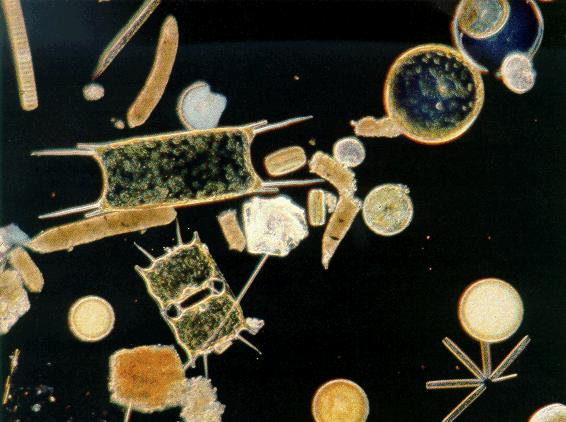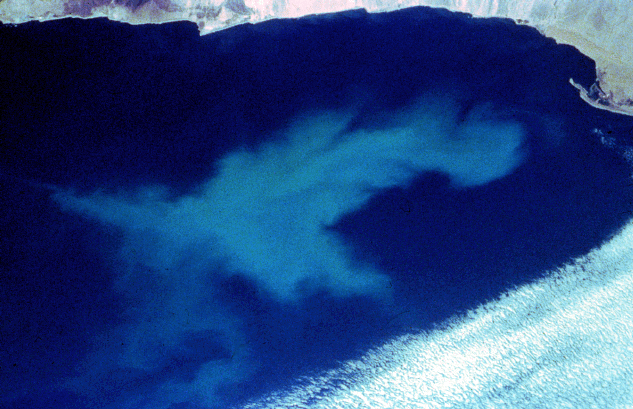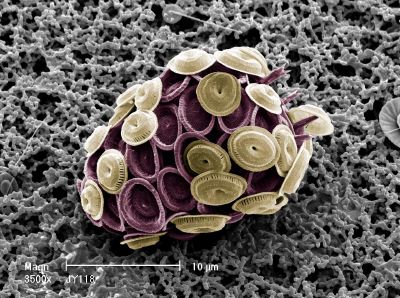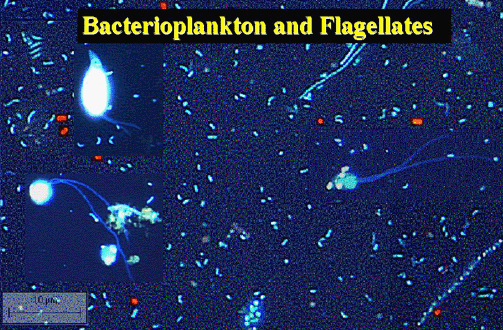 Phytoplankton
Phytoplankton
Major Phytoplankton Groups
2.1 Diatoms
2.2 Dinoflagellates
Characteristics
· Usually red or red-brown in color, due to carotene and xanthophyll pigments.
· Have flagella, and are motile. (Move vertically in response to light).
· Some can absorb organic substances from solution (heterotrophy).
· Most have “armor” made of cellulose.
· Many are bioluminescent (glow, especially when agitated).
Habitat
· Ubiquitous, favor warmer and more nutrient-depleted water than diatoms.
· In temperate regions, often “bloom” in late summer or early fall.
Dinoflagellates
and “Red Tides”
· Blooms of certain species of dinoflagellates give reddish or brownish color to the water.
· Some of these dinoflagellates produce toxins responsible for PSP (paralytic shellfish poisoning) or NSP (neurotoxic shellfish poisoning).For example: Gonyaulax and Ptychodiscus are major toxic species in U.S. waters.
· Shellfish accumulate the toxin as they filter-feed on algae. They are not affected by the toxin. Crabs, shrimp, fish, marine mammals, and humans are affected.
· The human lethal dose is ~1mg.
Symptoms
· Numbness (lips)
· Poor coordination, slurred speech
· Dizziness, nausea
· Paralysis, respiratory arrest leading to death.
Characteristics
· Golden-brown color owing to a pigment fucoxanthin in addition to chlorophyll.
· Diatoms have a frustule (shell-like covering) made of an organic matrix or framework impregnated with silica (SiO2)
· Diatoms have 2 basic shapes: centric and pennate
Habitat
· Ubiquitous, but most abundant in cold, nutrient-rich water. Often make up >45% of phytoplankton biomass in such waters. Often responsible for spring phytoplankton blooms in temperate and polar oceans. Also abundant in upwelling regions at low latitudes.
Siliceous sediments are often found under regions of high diatom productivity.
Safety Information
· Cooking does not destroy the toxin.
· Toxic organisms are endemic to Alaskan waters. This means that toxic shellfish can occur at any time of the year and at almost any location. A few beaches are generally safe (e.g. Clam Gulch) for unknown reasons.
· In general, it is a bad idea to eat mussels or clams collected on Alaskan beaches.
Occurrence and Causes of Harmful Algal Blooms
· Worldwide, harmful algal blooms (HABs) appear to be increasing in frequency or duration. Many of these are due to dinoflagellates, although other organisms, including diatoms, are involved.
· Possible causes of increased HABs are:
· Excessive nutrient input to coastal due to agricultural fertilizers, sewage
·
Transport
of new species from their habitat to new locations, mostly in ships  ballast water
ballast water
Climatic warming
2.3 Coccolithophores
Characteristics
· Occur as single cells.
· Covered by plates made of calcite (calcium carbonate) called coccoliths which make up some calcareous sediments on the sea floor.
· Have 2 flagella.
· Are smaller in size than most diatoms or dinoflagellates.
Habitat
· Dominate in warm, low nutrient, low productivity waters of the oceans.
However, blooms occur in colder waters as well, e.g., Bering Sea since 1997, North Atlantic, Barents Sea
3. Bacterioplankton

The most abundant organisms in the ocean (1,000,000 per ml). Have the greatest “standing stock” of biomass in low-productivity regions of the ocean.
Characteristics
· Very small (usually <1µm in diameter). Prokaryotes (lack nuclear membrane). Come in many shapes:
· May be either free or attached to surfaces, including other organisms.
Habitat
· Everywhere.
· Cyanobacteria are more numerous than other primary producers where nutrient concentrations are very low, because they have the ability to fix nitrogen.
· Heterotrophic bacteria are more numerous where there is a lot of organic material, i.e., areas of high primary productivity
Role
· Primary producers or decomposers of organic matter and recyclers of nutrients.
· “Blue-green algae” are actually prokaryotic organisms that are bacteria, not algae. They are photosynthetic (autotrophic) primary producers.
Heterotrophic bacteria are the main decomposers of the sea, and are responsible for most nutrient recycling and oxygen consumption in the oceans.
4. Summary
(1) Plankton are drifting organisms at the mercy of the currents.
(2) There are 3major groups of plankton, phytoplankton, the main primary producers of the ocean; bacterioplankton, which can be either primary producers or decomposers; and zooplankton, which are animals.
(3) The four major groups of primary producers (autotrophs) in the ocean are:
diatoms, golden-brown algae with siliceous frustules that are commonest in cold, nutrient-rich water
coccolithophores, algae that are covered with small, calcareous plates (coccoliths) and are commonest in warm, tropical waters.
dinoflagellates, red or brown algae that usually have hard coverings of cellulose and are motile by means of a flagellum. They are commonest in summer and fall in the temperate zone of the oceans, and can cause PSP.
cyanobacteria (blue-green algae) are really bacteria that are photosynthetic primary producers, commonest in nutrient-depleted areas of the open ocean.
Sign Guestbook View Guestbook
|



